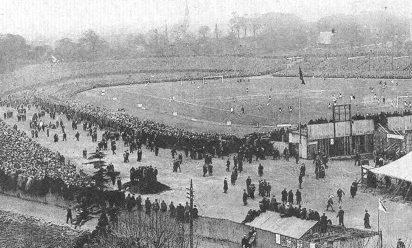100 years on: Our first FA Cup final
The Barclays Premier League title is the item of silverware uppermost on everyone's mind at the minute, but a century ago it was the FA Cup that was the object of every Liverpudlian's desire.
At the time there was no greater prize in football and 100 years ago today the club competed in the final for the first time.
Ultimately, it was a day that ended in disappointment with the Reds losing 1-0 to Burnley at Crystal Palace, but it remains a momentous event in our history and on this milestone anniversary of the occasion, here's the story of the 1914 FA Cup final...
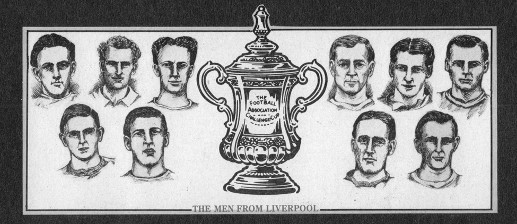
Liverpool's record in the FA Cup prior to 1914 was a poor one. Their previous best run in the competition had been reaching the semi-finals of 1899 and 1906.
Barnsley, Gillingham, Queens Park Rangers and West Ham United were all defeated en route to another last-four tie in 1914 but the Reds were considered rank outsiders against renowned 'cup specialists' Aston Villa at White Hart Lane.
Two Jimmy Nicholl goals, though, sealed a surprise victory and when that news was relayed back to Anfield, where a reserve match was taking place, it was reported that 'scenes unprecedented in the history of the club were witnessed between players and spectators alike.'
Burnley saw off the challenge of South Shields, Bolton, Derby, Sunderland and Sheffield United to book their place at Crystal Palace, and, like Liverpool, this was also to be their first ever appearance in the final.

The Liverpool squad pictured at Anfield prior to leaving for their cup final base at the Forest Hotel in Chingford, Essex. Back row (left to right): Bill Connell (trainer), Sam Speakman, Donald MacKinlay, Ephraim Longworth, Kenneth Campbell, Thomas Fairfoul, Robert Pursell, Tom Miller, Tom Watson (manager). Front row (left to right): Jackie Sheldon, Arthur Metcalfe, Robert Ferguson, Harry Lowe, Bill Lacey, Jimmy Nicholl.
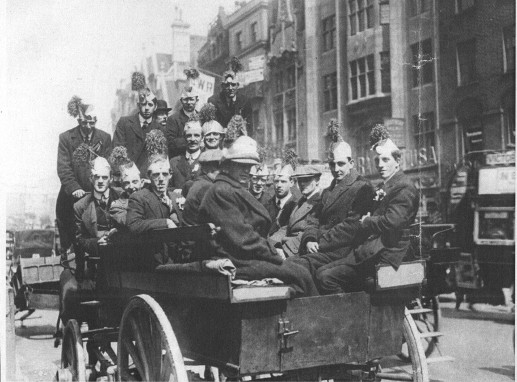
The support for Liverpool at the final could not be faulted. Despite the increasing threat of war, there was no lack of enthusiasm for football and up to 20,000 Liverpudlians journeyed south to witness the biggest game of their lives.
The majority left by train from Lime Street, the first battalions departing on Friday evening and many more following the next morning. All were in high spirits and confident that their team could bring the cup home for the first time.
The travelling Reds pictured above, enjoying their day out in the capital on a horse-drawn carriage, were smartly kitted out in the fashionable match-going attire of the day - overcoats and three-piece suits, not forgetting, of course, their specially made red and white 'cup final' hats and matching 'cup final' button-holes.

Liverpool and Burnley had already met on two occasions in the First Division that season. The first game at Anfield ended in a 1-1 draw but just six weeks before the final the Clarets ran out 5-2 winners at Turf Moor. That season's final league table saw Liverpool finish in 16th position, four places below Burnley, with just one point separating them.
This was the first-ever FA Cup meeting between the two teams and Liverpool were rated as 4-6 favourites to claim victory.
Despite the eventual result, an original, mint condition, match programme, as pictured above, is one of the most sought-after items of memorabilia by Liverpool collectors.

In the build-up to the game, Liverpool's main worry concerned the condition of captain Harry Lowe. Trainer Bill Connell was optimistic that the influential half-back would be fit but, after being put through a rigorous fitness test on the morning of the match, Lowe was sadly ruled out. He was replaced in the team by young Don MacKinlay, with Bob Ferguson moving from left-half to centre-half and taking possession of the skipper's armband.
Burnley also suffered a late withdrawal. Regular goalkeeper Jerry Dawson fell ill shortly before kick-off and had to be replaced between the sticks by deputy stopper Ronnie Sewell.
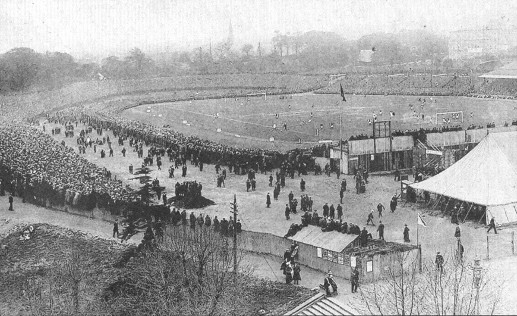
Crystal Palace, in Sydenham, South London, was the chosen neutral ground to host the final. It had staged 19 previous FA Cup finals since 1895 but this was to be its last. As well as a football ground it was also home to a popular Victorian amusement park. Before gaining entry to the ground, spectators also had to pay an admission fee for the park.

Although regarded as a 'grand venue' Crystal Palace was also renowned for its poor sightlines. The official attendance for the 1914 final - 72,778 - was considerably lower than the 121,919 that had crammed in to see the previous year's final but decent vantage points remained few and far between. Many supporters were forced to climb the surrounding trees, while these determined spectators perched perilously on wooden posts in order to gain a better view.
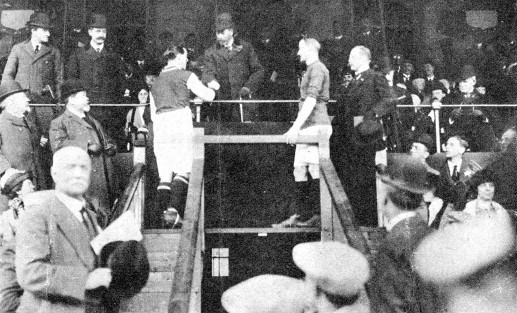
King George V shakes hands with the two captains prior to kick-off. This was the first time a reigning monarch had attended the FA Cup final and his presence generated huge interest. After coming out onto the pitch, the two teams lined up in front of the King and gave three cheers in his honour.
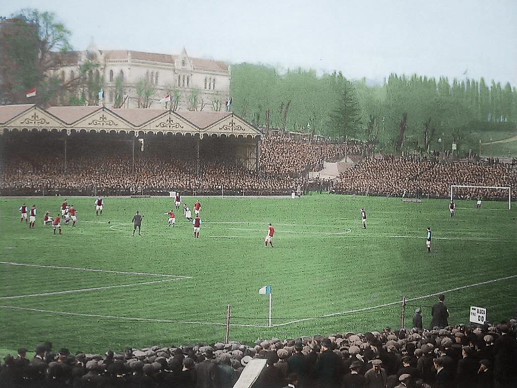
A rare colour action image of the game.
On a warm but overcast afternoon, the two teams sported their traditional colours. Liverpool lined up in 2-3-5 formation and dominated the first half but failed to convert their possession into goals. Miller was guilty of squandering the best chances and the Daily Post later reported: 'Cleverness without finish counts for nothing.'
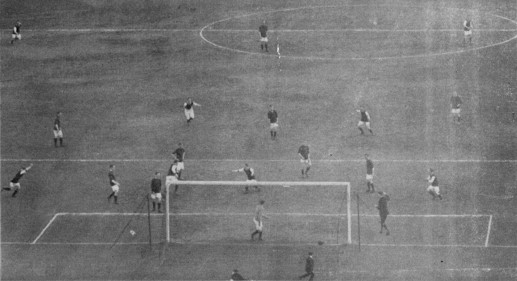
After the break Burnley showed signs of improvement and took the lead in the 57th minute with a goal that was described as 'good enough to win any game.' It was scored by ex-Everton forward Bert Freeman and Campbell in the Liverpool goal was given no chance.
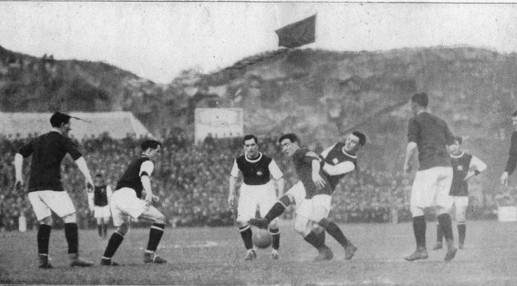
Liverpool tried their best to find an equaliser but it was sadly not to be their day. Although bitterly disappointed to have lost, the game had been played in a great spirit and defeat was accepted graciously by Tom Watson and his players.
'It was a blow to Liverpool - unexpected, galling, yet bearable. Therefore we smile,' wrote Echo reporter 'Bee'. 'Liverpool can bear their defeat with manliness. They have many pleasant recollections and rewards.'
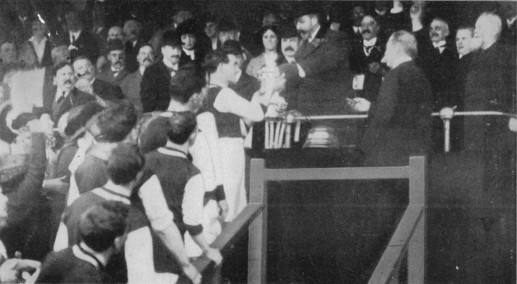
Burnley captain Tommy Boyle collects the FA Cup from the King.
But just four days later the cup did find its way to Anfield. Prior to the final, Tom Watson had proposed that whatever the result at Crystal Palace, the two finalists should meet again in a charity match at Anfield where the cup could be paraded by the victors to raise money for the Theatrical Gala fund. A crowd of 10,000 attended and they witnessed a 1-0 victory for Liverpool.
Both teams were photographed with the FA Cup but it would be another 51 years before Liverpool finally got their hands on the coveted trophy for real.
A special thanks to LFC archivist Adrian Killen for kindly supplying, from his scrapbooks, the majority of images for this feature.


